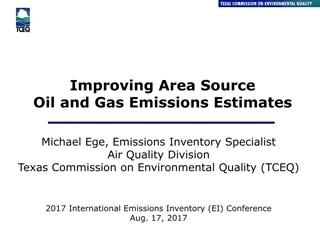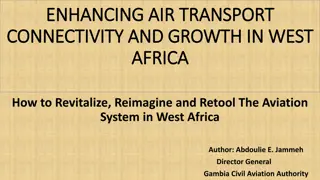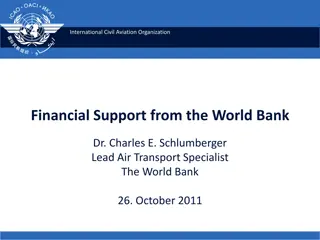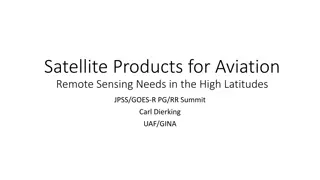
Aviation Emissions Control Market
The global emissions from commercial aviation amounted to 865.72 MMT of CO2 in 2021, and it is expected to grow at a CAGR of 3.03% and reach 1,203.42 MMT of CO2 by 2032.nnRead Report Overview: //bisresearch.com/industry-report/aviation-emission
Download Presentation

Please find below an Image/Link to download the presentation.
The content on the website is provided AS IS for your information and personal use only. It may not be sold, licensed, or shared on other websites without obtaining consent from the author. If you encounter any issues during the download, it is possible that the publisher has removed the file from their server.
You are allowed to download the files provided on this website for personal or commercial use, subject to the condition that they are used lawfully. All files are the property of their respective owners.
The content on the website is provided AS IS for your information and personal use only. It may not be sold, licensed, or shared on other websites without obtaining consent from the author.
E N D
Presentation Transcript
Aviation Emissions Control Market Overview: Exploring Business Potential and Regional Forecast to 2042 As concerns about climate change continue to grow, the aviation industry faces increasing pressure to reduce its environmental impact. Aircraft emissions, particularly carbon dioxide (CO2) and nitrogen oxides (NOx), contribute to global warming and air pollution. To address these challenges, the aviation emissions control market has emerged, offering innovative technologies and solutions to mitigate emissions while sustaining the industry's growth and connectivity. According to BISResearch, the global Aviation Emissions Control Market amounted to 865.72 MMT of CO2 in 2021, and it is expected to grow at a CAGR of 3.03% and reach 1,203.42 MMT of CO2 by 2032.
Aviation emissions primarily consist of carbon dioxide (CO2), nitrogen oxides (NOx), particulate matter (PM), and water vapor. These emissions contribute to climate change, air quality degradation, and other environmental concerns. While aircraft CO2 emissions receive significant attention due to their long-term impact on climate, NOx emissions also play a crucial role in the formation of ozone and other pollutants in the atmosphere. Understanding the Aviation Emissions Control Market: The aviation emissions control market encompasses a wide range of technologies, products, and services aimed at reducing greenhouse gas emissions and improving air quality. Key components of this market include: 1. Emissions Reduction Technologies: These include advancements in aircraft engine design, aerodynamics, and materials to improve fuel efficiency and reduce CO2 and NOx emissions. Technologies such as lean-burn combustion, advanced turbofan engines, and lightweight materials play a crucial role in emissions control. 2. Alternative Fuels: Sustainable aviation fuels (SAFs) derived from renewable sources such as biomass, waste oils, and synthetic processes offer a lower-carbon alternative to conventional jet fuel. The market for alternative fuels is expanding rapidly, driven by government mandates, corporate sustainability goals, and increasing investment in biofuel production. 3. Emissions Monitoring and Reporting Systems: Regulatory requirements and industry standards necessitate accurate monitoring and reporting of aircraft emissions. Emissions monitoring systems, onboard sensors, and data analysis software enable operators to track emissions performance and comply with environmental regulations. 4. Emissions Trading and Offsetting Programs: Market-based mechanisms such as emissions trading schemes (ETS) and carbon offsetting programs provide incentives for airlines to reduce emissions and invest in emissions reduction projects. Carbon credits and offset certificates facilitate the financing of emission reduction initiatives, driving market growth in this segment. Request A Detailed Sample on Aviation Emissions Control Market! Aviation Emissions Control Market Dynamics: Several factors are driving the growth of the aviation emissions control market: 1. Stringent Environmental Regulations: Regulatory initiatives such as the Carbon Offsetting and Reduction Scheme for International Aviation (CORSIA) and emissions reduction targets set by regulatory bodies like the International Civil Aviation Organization (ICAO) compel airlines to invest in emissions control technologies and solutions. 2. Corporate Sustainability Initiatives: Airlines and aircraft operators are increasingly adopting sustainability as a core business objective, driven by customer demand, investor pressure, and reputational considerations. Investing in emissions control measures aligns with corporate sustainability goals and enhances brand reputation. 3. Rising Fuel Costs and Volatility: Fluctuations in fuel prices and the long-term trend of rising fuel costs incentivize airlines to improve fuel efficiency and reduce emissions. Emissions control technologies offer potential cost savings through reduced fuel consumption and operational efficiency gains.
4. Technological Advancements and Innovation: Ongoing research and development efforts in areas such as engine efficiency, aerodynamics, and alternative fuels drive technological innovation in the aviation emissions control market. Advancements in electric propulsion, hydrogen fuel cells, and sustainable aviation fuels present new opportunities for emissions reduction. Market Outlook: The aviation emissions control market is poised for significant growth in the coming years, driven by regulatory mandates, industry initiatives, and technological advancements. As the industry strives to decarbonize and improve air quality, investments in emissions reduction technologies, alternative fuels, and emissions trading programs will continue to accelerate, shaping the future of sustainable aviation. Get Insights on spacetech market research reports Conclusion: The aviation emissions control market plays a crucial role in addressing the environmental challenges associated with air travel while supporting the industry's continued growth and sustainability. By leveraging innovative technologies, market-based incentives, and collaborative efforts among stakeholders, the aviation industry can mitigate its environmental footprint and pave the way for a greener and more sustainable future of flight.






















